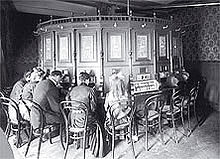Kaiser panorama

The Kaiserpanorama (also known as Kaiser Panorama ) is a mass medium popular around the turn of the 20th century that allowed up to 25 people to view stereoscopic image series through a peephole at the same time. Mainly exotic travel destinations and landscapes that are unaffordable for ordinary people were shown. One cycle of the series of images, which were automatically transported in a circle behind a cylindrical wood paneling, took half an hour.
This massive commercial use of stereoscopy for educational and entertainment purposes was promoted by the German physicist and entrepreneur August Fuhrmann (1844–1925) in various major cities in Central Europe. He opened the first Kaiser Panorama in 1880 in Breslau . In 1883 he moved it to Berlin in the Kaiserpassage . By 1910 there were branches in about 250 cities on the basis of licensing ; Over 100,000 stereoscopic images circulated in a row. Originally preserved imperial panoramas can be found today in the city museums of Munich and Wels , in the German Historical Museum and in the Märkisches Museum in Berlin as well as in a museum depot in Neugersdorf (Upper Lusatia), where it was operated until 1936. A sponsoring association tries to propagate it, and replicas have also been made. In Vienna there was an original Kaiserpanorama on Schubertring until 1955. In Warsaw , an Kaiserpanorama device, called a “ photoplasticon ”, has been in operation since 1905 at its original location at Jerozolimskieallee 51.
The Kaiserpanorama also found a literary echo several times, for example in The Sleepwalkers by Hermann Broch or in Berlin Childhood around 1900 and One-Way Street by Walter Benjamin .
literature
- Dieter Lorenz, Ulrich Pohlmann: The Kaiser Panorama. A company of August Fuhrmann. Münchner Stadtmuseum , Photography Collection, Munich, 2010, ISBN 978-3-934609-09-9
- Annelen Karge: The Kaiser Panorama. A three-dimensional look into history , ed. by the Hanseatic City of Rostock, Kulturhistorisches Museum with the support of the Ministry for Education, Science and Culture Schwerin, Rostock: Kulturhistorisches Museum, 2008
- Michael Bienert, Erhard Senf: Berlin is becoming a metropolis. Images from the Kaiser Panorama. be.bra, Berlin 2000, ISBN 3-930863-64-2 .
- Karin Gaa, Bernd Krüger, (Berliner Festspiele (Hrsg.)): Berlin around 1900. Das Kaiserpanorama. Pictures from Berlin at the turn of the century. Berlin 1984.
- Karsten Hälbig: The Kaiser Panorama Celle, Berlin branch , ed. With a view to the 700th anniversary of the city of Celle in 1992, in the series of publications by the Celle City Archives and the Bomann Museum , Issue 21, 1992, ISBN 3-925902-13-9
- August Fuhrmann (Hrsg.): Golden book of the central office for Kaiser panoramas. Self-published, Berlin 1909
- Marga Burkhardt: Freiburg cinema landscape until 1919 - Camera obscura and Kaiser Panorama , in: Freiburg-Postkolonial
Timetable
- from 1600: Flip book - flip book with individual images
- from 1671: Laterna magica - magic lantern: early device for image projection
- from 1825: Thaumatrop - miracle disc with two threads
- from 1830: Phenakistiskop - phantascope, miracle wheel or wheel of life
- from 1832: stroboscope - magic disks: flash unit
- from 1834: Zoetrop - miracle drum with slots
- from 1861: Mutoskop - stereo animation sheets per stroboscope
- from 1877: Praxinoscope - electrical high-speed viewer using a mirror arrangement
- from 1879: Zoopraxiskop - projection device for chronophotographically generated serial images
- from 1880: Kaiserpanorama - popular mass medium with stereoscopic picture series
- from 1886: Electrotachyscope - projection device for row images
- from 1891: Kinetoskop - first film viewer
Web links
- DHM object database (approx.11,000 motifs)
- Permanent exhibition of the Märkisches Museum: The Kaiserpanorama. Stadtmuseum Berlin Foundation - State Museum for Culture and History of Berlin, online .
- Bernd Poch: The Kaiser Panorama. The medium, its predecessors and its distribution in northwest Germany
- Sylke Kirschnick, a thousand and one signs ... Paragraph I.3. Description of the then "Institute for Optical Travel" in the Kaiserpassage with Benjamin quotes
- The Kaiserpanorama at Mark Witkowski (English)
Individual evidence
- ↑ Susanne Müller: The world of Baedeker . A media culture history of the travel guide 1830–1945 . Campus publishing house, Frankfurt a. M. / New York 2012, p. 172
- ↑ Full text at Wikisource: One-way street

